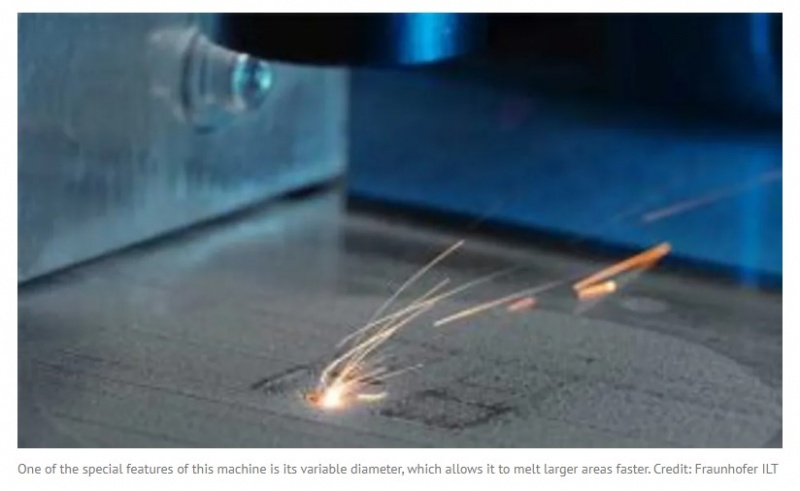
Metal 3D printing can also be known as DMLS (Direct Metal Laser Sintering), and DMLM (Direct Metal Laser Melting) is an additive layer technology. A metal 3D printer uses a laser beam to melt 20-60 micron layers of metal powder on top of one another. This powdered metal is spread out over the entire build platform and selectively melted to the previous layers of the build.
This process, known as an additive process, allows metal structures/products/parts to be “grown” out of powdered metal. Other polymer based 3D printers work in a similar fashion.
Not unlike other facets of 3D printing, metal 3D printing is a hi-tech, relatively new process that is constantly being improved and changed. A revolutionary new metal 3D printing technology has emerged recently that looks like it could totally overhaul the metal 3D printing process for the better. Read on to find out more!
No Lasers, Just LED
This new revolutionary technology comes in the form of SLEDM (Selective LED-based Melting). This involves the targeted melting of metal powder using high-power LED light sources, and a man by the name of Franz Haas is the head of the team responsible for the development of this new method. The patent has been applied for and the team at the Institute of Production Engineering are now waiting patiently for its approval.
The new technology is quite similar to SLM (Selective Laser Melting), and EBM (Electron Beam Melting), where the same metal powder is melted by an electron beam or a laser and layered up to create the desired finished product. The two problems with the existing technology that SLEDM solves are both time related: the long timeline for the manual post-processing of the product, and the length of time that it takes to produce “large-volume” metal components.
No More Manual Reworking
A newly designed production plant accompanies this new method, and this has a feature that no other metal melting plants have; the ability to add the metal component from top to bottom. As a result of this the component is exposed, which enables the operator to use the least amount of metal powder possible and reworking can be carried out during the printing process!
Necessary finishing touches like removing supporting structures that strengthen the 3D printed part and smoothing out rough surfaces are no longer left to the end of the manufacturing and are incorporated into the initial printing process. This is possible due to the extremely tight focus of light energy, therefore saving time and money.
Quicker Finished Product
The SLEDM method uses a high-power LED beam to melt the metal powder, unlike the EBM & SLM processes, which as mentioned above, uses an electron beam and laser respectively. Typically, SLM and EBM technologies are used in applications requiring complex metal parts, in industries such as aerospace. For example, the European Space Agency (ESA) used SLM 3D printing to fabricate a full scale, 3D printed rocket engine, which it tested for the first time in 2019. California-headquartered aerospace company Rocket Lab leverages EBM to produce its 3D printed Rutherford rocket engines, which powers the firm’s Electron Rocket.
Both of these processes are also seeing research projects and updates that aim to develop their capabilities further. Recently, researchers from Texas A&M University established a method of using SLM to 3D print complex steel structures free from porosity. UK-based engineering firm Wayland Additive announced a new EBM process known as NeuBeam, which it hopes to commercialize by the end of the year.

These special Light-Emitting Diodes used in SLEDM were specifically created by Preworks, a west Styrian lighting specialist. These LEDs were then equipped with a complex lens system, this made the diameter of the LED focus easily changed between 0.05 and 20 millimeters during the melting process. The secret here is in the focusing. Imagine taking the light required to illuminate an entire theater and focusing it down to a mere 1mm diameter spot. That’s how they gain sufficient energy to melt metal powder.
This also allows larger volumes of metal to be melted, and because of this there is no need for filigree internal structures, thus reducing the production time of components for medical or fuel cell technology for example, by an average of a factor of 20!
Variety of Applications
A demonstration of the SLEDM process is already being considered at the Medical University of Graz, where the first laboratory for medical 3D printing was opened in October 2019. The SLEDM process in particular will be used to produce bioresorbable metal implants, in layman’s terms this refers to screws made out of magnesium alloys that are used for bone fractures. These implants dissolve in the body after the fracture site has grown together. This negates the second surgery that is needed with these types of injuries, which is definitely huge, especially for the patient!
Furthermore, the production of such implants will be possible within the operating theatre itself, thanks to the SLEDM process using a less harmful LED light rather than a powerful laser.
The second focus for this method is sustainable mobility, for example the production of components for batteries and bipolar plates for fuel cells. It is the aim to make SLEDM economically viable for e-mobility and insert SLEDM into this field of research as soon as possible.
For the next step in the development process, a marketable prototype of the new metal 3D printer will be made with the hope of further testing and innovation in these areas using this machine. It is clear to see the many advantages of this groundbreaking printer and its revolutionary technology. The medical and fuel cell industries were mentioned specifically in this article, but the list of areas of industry that would be affected by this machine would be a very long list indeed.
Not to mention engineering, where a 3D printer has become one of the essential new-age tools for increasing productivity in the design process for mechanical engineers among others.


